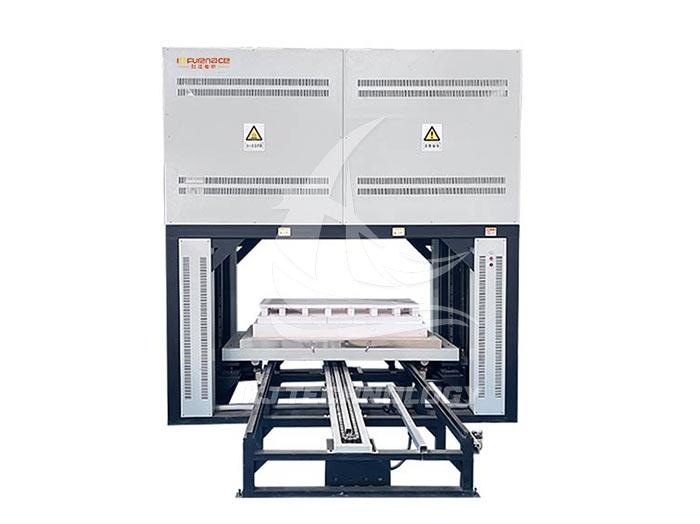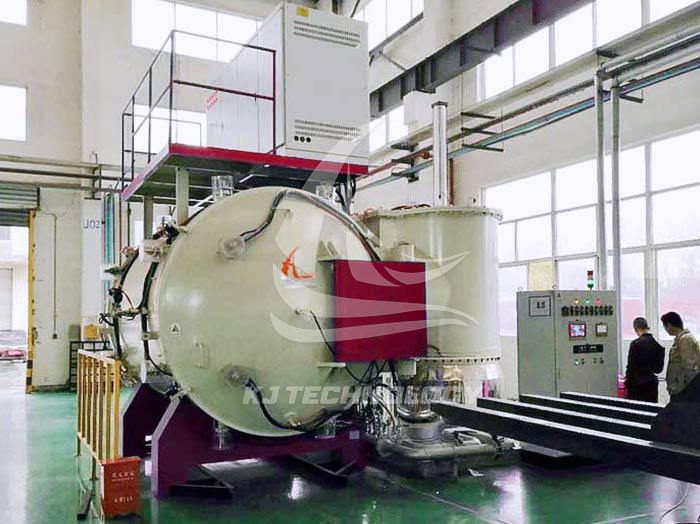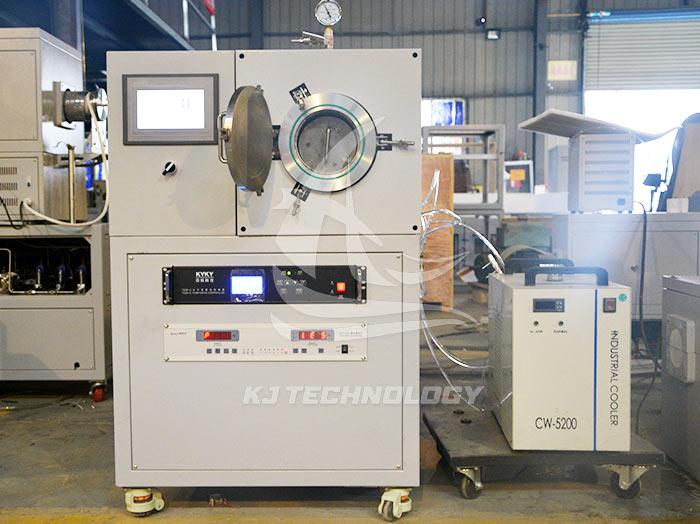What are the application scenarios of vacuum heat treatment atmosphere electric furnace?
 06-30-2025 Author: KJ technology
06-30-2025 Author: KJ technology
The vacuum heat treatment atmosphere electric furnace, by combining vacuum environment and controllable atmosphere technology, has shown a wide range of application scenarios in the field of material processing, especially suitable for industries with strict requirements for material properties, surface quality, and process accuracy. The following are its core application scenarios and typical case analysis:
1. Aerospace field: High performance material processing
Heat treatment of aircraft engine blades
Scenario: Nickel based high-temperature alloy (such as Inconel 718) blades need to maintain high strength, creep resistance, and corrosion resistance at high temperatures.
Process: Vacuum solution treatment (1150-1200 ℃) combined with aging treatment (720 ℃/8h) to eliminate casting stress and precipitate strengthening phase (γ 'phase).
Advantages:
Vacuum environment avoids surface oxidation of blades and reduces fatigue crack sources.
Atmosphere control (such as argon protection) prevents the volatilization of alloy elements (such as Al, Ti) and ensures the uniformity of composition.
Effect: The creep life of the blades is increased by 40%, and the high-temperature endurance strength is increased by 25%.
Processing of titanium alloy structural components
Scenario: Aircraft landing gear, fasteners, and other components that require both lightweight and high-strength.
Process: Vacuum annealing (800-900 ℃) to remove work hardening, combined with hydrogen atmosphere to reduce surface oxide layer.
Advantages:
The hydrogen atmosphere can reduce TiO ₂ on the surface of titanium alloys and improve fatigue performance.
Vacuum environment suppresses hydrogen embrittlement and ensures material toughness.
Effect: The hydrogen embrittlement sensitivity index (HSI) of fasteners has been reduced from 0.8 to 0.2, significantly improving safety.
2. Automotive Industry: Strengthening of Key Components
Gear carburizing and quenching
Scenario: Automotive transmission gears require high surface hardness (HRC 58-62) and core toughness (AKV ≥ 30J).
Process: Vacuum low-pressure carburizing (900-950 ℃, carbon potential 1.2%)+high-pressure gas quenching (5 bar nitrogen).
Advantages:
Low pressure carburizing achieves carbon concentration gradient control and surface hardness uniformity of ± 1 HRC.
High pressure gas quenching reduces deformation (≤ 0.1mm) and eliminates subsequent grinding processes.
Effect: Gear contact fatigue life is increased by 50%, and noise is reduced by 3dB.
Surface modification of mold steel
Scenario: Die casting molds require heat fatigue resistance (600-700 ℃) and resistance to molten metal erosion.
Process: Vacuum nitrogen carbon co diffusion (550-600 ℃, NH ∝+CO atmosphere) forms a compound layer (ε phase+γ 'phase).
Advantages:
The vacuum environment ensures the uniformity of the infiltration layer (thickness 15-20 μ m) and no surface oxidation.
The hardness of the nitrogen carbon co diffusion layer reaches HV 1000-1200, and the wear resistance is increased by three times.
Effect: The lifespan of the mold has been extended from 80000 cycles to 250000 cycles.
3. Medical devices: Processing of biocompatible materials
Artificial joint surface treatment
Scenario: Cobalt chromium alloy (CoCrMo) hip joints require resistance to body fluid corrosion and low ion precipitation.
Process: Vacuum annealing (1100 ℃) to eliminate processing stress, surface oxidation treatment (500 ℃/2h air) to form a dense Cr ₂ O3 film.
Advantages:
Avoid nickel ion precipitation in a vacuum environment (Ni content ≤ 0.1%), with a biocompatibility compliance rate of 99%.
The thickness of the oxide film is 2-5 μ m, and the corrosion resistance is improved by 10 times (salt spray test ≥ 1000h).
Effect: The postoperative inflammatory response rate decreased from 15% to 2%.
Titanium alloy implant processing
Scenario: Dental implants require high strength (UTS ≥ 800 MPa) and osseointegration.
Process: Vacuum sintering (1300 ℃) combined with hydrogen reduction, surface sandblasting+acid etching treatment.
Advantages:
Vacuum sintering eliminates pores (porosity ≤ 0.5%) and improves fatigue strength.
Hydrogen reduces surface TiO ₂ and promotes bone cell adhesion (surface roughness Ra 1.5-2.0 μ m).
Effect: The initial stability of the implant is improved by 40%, and the osseointegration time is shortened by 2 weeks.
4. Powder metallurgy industry: preparation of high-performance materials
Sintering of Hard Alloy Cutting Tools
Scenario: WC Co hard alloy drill bits require high hardness (HRA 91-93) and impact resistance.
Process: Vacuum liquid-phase sintering (1400-1450 ℃), controlling the uniformity of cobalt phase distribution (σ ≤ 5%).
Advantages:
Vacuum environment avoids carbon loss and ensures WC grain size (0.8-1.2 μ m).
Liquid phase sintering achieves full densification (density ≥ 14.5 g/cm ³).
Effect: The bending strength of the cutting tool is ≥ 3000 MPa, and the service life is doubled.
Heat treatment of magnetic materials
Scenario: NdFeB permanent magnets require high coercivity (Hcj ≥ 20 kOe) and remanence (Br ≥ 1.3 T).
Process: Vacuum annealing (1050 ℃) to eliminate grain boundary defects, surface aluminum plating protection.
Advantages:
Vacuum environment suppresses oxidation and reduces coercive force attenuation (Δ Hcj ≤ 5%).
Aluminum coating (thickness 5-10 μ m) enhances corrosion resistance (salt spray test ≥ 500h).
Effect: The working temperature of the magnet has been increased from 80 ℃ to 120 ℃.
5. Electronics and Semiconductor Industry: Precision Component Processing
Ceramic packaging substrate sintering
Scenario: Aluminum nitride (AlN) ceramic substrates require high thermal conductivity (≥ 170 W/m · K) and low dielectric loss.
Process: Vacuum hot pressing sintering (1800 ℃/30 MPa), adding Y ₂ O ∝ sintering aid.
Advantages:
Vacuum environment promotes densification (density ≥ 3.2 g/cm ³) and reduces porosity.
The hot pressing process controls grain growth (average particle size 5-8 μ m) and improves thermal conductivity.
Effect: The thermal cycle life of the substrate has been extended from 1000 times to 5000 times.
Metal glass forming
Scenario: Zirconium based amorphous alloys (Zr ₄₁ Ti ₁₄ Cu ₁₂ Ni ₁₀ Be ₂ ∝) require rapid cooling (≥ 10 ⁵ K/s) to form an amorphous structure.
Process: Vacuum induction melting+copper mold spray forming, atmosphere control (argon pressure 0.5 MPa).
Advantages:
Avoid impurities from entering the vacuum environment and ensure the ability to form amorphous materials (XRD without crystallization peaks).
Copper mold spraying achieves high cooling rate and dimensional accuracy of ± 0.05mm.
Effect: The tensile strength of amorphous alloy reaches 1800 MPa, and the elastic strain limit is 2.2%.
6. New energy field: battery material processing
Sintering of positive electrode materials for lithium-ion batteries
Scenario: NCM (LiNi ₓ Co ᵧ Mn ₁₋ₓ₋ᵧ O ₂) ternary material requires high capacity (≥ 180 mAh/g) and cycling stability.
Process: Vacuum segmented sintering (700-900 ℃), oxygen atmosphere (O ₂ concentration ≥ 95%) promotes the formation of layered structure.
Advantages:
Vacuum environment reduces Li volatilization (Li content loss ≤ 1%) to ensure capacity stability.
The oxygen atmosphere inhibits the oxidation of Ni ² ⁺ to Ni ³ ⁺, improving the cycle life (500 times capacity retention rate ≥ 90%).
Effect: The specific capacity of the positive electrode material is increased by 10%, and the cost is reduced by 15%.
Bipolar plate treatment for hydrogen fuel cells
Scenario: Graphite/metal composite bipolar plates require high conductivity (≤ 10 m Ω· cm ²) and corrosion resistance.
Process: Vacuum carbonization (1000 ℃) combined with resin impregnation, surface gold plating (thickness 0.1 μ m).
Advantages:
Vacuum carbonization enhances the crystallinity of graphite (grain size ≥ 50nm) and reduces contact resistance.
The gold coating has excellent corrosion resistance (potential+1.0 V vs. SCE corrosion free).
Effect: The lifespan of the bipolar plate has been extended from 5000h to 20000h.








